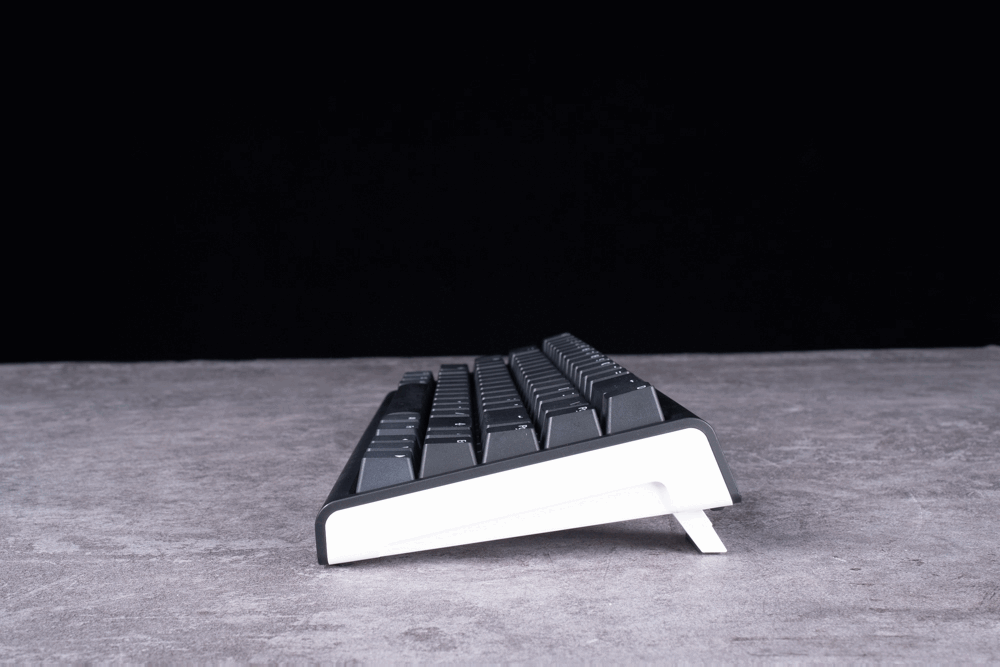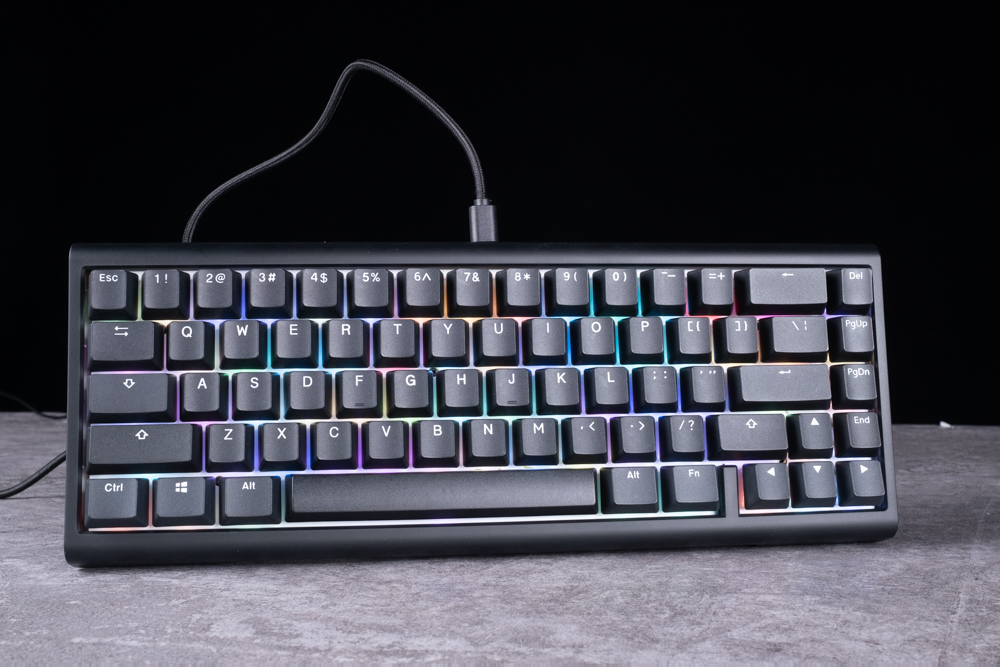
Ducky’s specialized mechanical keyboard brand, ProjectD, has recently unveiled its latest DIY masterpiece, the “ProjectD Tinker 65,” following the success of its flagship series, ProjectD Outlaw. The Tinker 65, with its striking black and white design, subtly nods to a popular, action-packed anime famous for its tofu delivery storyline. As a 65% customizable keyboard, the Tinker 65 is more affordably priced than its flagship counterpart, the Outlaw, aligning with Ducky ProjectD’s mission to offer personalized style in keyboard products. The Tinker 65 is available as a Barebone kit without keycaps or switches, but it also offers an array of options including Cherry MX switches in various types and durable, stain-resistant PBT double-shot keycaps, making it an accessible choice for beginners aiming to craft their perfect keyboard.
Specifications:
- Layout: 65%
- Hot-Swappable Sockets: Yellow Kailh sockets supporting hot-swapping
- Mounting Design: Gasket Mount
- Plate Material: FR-4 Glass Fiber
- Dampening Material: Poron silent sandwich, PE silent bottom cotton
- Backlighting: RGB with South-facing arrangement
- Switch Options: Hot-swappable (Red, Blue, Brown, Silver)
- Keycaps: Double-shot molding
- Connectivity: USB 2.0 (Type-C to Type-A) with a braided detachable cable
- Ghosting Prevention: N-Key Rollover for full anti-ghosting
- Macro Support: QMK / VIA compatible
- Adjustable Stand: 3-step height adjustment
- Dimensions: 320 x 125 x 40mm
- Weight: 590g
- Manufactured in: Taiwan
Ducky ProjectD Tinker 65 Appearance and Gasket Mount Structure
The Ducky ProjectD Tinker 65 showcases a distinct black and white color scheme, featuring a black top cover that reveals a white plate and bottom cover when the keycaps are removed. This color distribution, along with the brand name, evokes images of the iconic tofu delivery car dominating Mount Akina. The keyboard’s slim bezel design contributes to its sleek and tidy overall appearance. The keyboard’s underside features a curved design, and its compact size and weight, just under 600g, make it highly portable.
In terms of internal structure, the Tinker 65 employs an FR-4 glass fiber material for the plate, coupled with Poron foam for sound dampening, integrated within a Gasket Mount design for a secure and snug top and bottom cover fit. This selection of materials and design effectively softens the sound of keystrokes while eliminating metallic reverberations, resulting in a pleasant and crisp typing sound. The mechanical design uniformly reduces the after-echo of each keystroke, enhancing the overall typing experience.







Easy customization of Ducky ProjectD Tinker 65|Hot-swappable, RGB, QMK/VIA function support

The Ducky ProjectD Tinker 65, true to its name, features a 65% keyboard layout. It thoughtfully retains essential keys such as Del, PgUp, PgDn, End, and arrow keys, making it particularly convenient for users who frequently utilize text selection in their typing. The keyboard is designed with several pre-set Fn key combinations, eliminating the hassle of initial key configuration. For instance, Fn + R instantly toggles the RGB lighting, while Fn + T switches between built-in RGB light effects. This model comes with all the essential combo keys one might need.
Moreover, the Tinker 65 supports hot-swappable switches, maintaining the customizable elements of its flagship counterpart, the Outlaw. Users can intuitively and swiftly modify basic keyboard settings via the QMK / VIA software, such as adjusting RGB color schemes, speed, and direction. Of course, this software also allows for the customization or modification of key combinations, offering a high degree of personalization to the user’s experience.










For keyboard enthusiasts with advanced customization needs, the QMK framework offers the capability to write their own firmware programs, unlocking an array of unique custom functions for their keyboards. QMK’s versatility is ideal for various DIY keyboard firmware projects. However, implementing these customizations requires the use of QMK Toolbox for firmware flashing. This method is particularly recommended for advanced users who are looking to take their keyboard customization to the next level.

For beginners or those who don’t have high demands for advanced keyboard macros and settings, the officially supported VIA feature is an excellent choice. VIA allows for quick and easy adjustments of most basic keyboard settings, such as RGB lighting or remapping keys. This user-friendly interface provides a straightforward solution for those looking to customize their keyboards without delving into more complex configurations.

Layers of sound-absorbing, high-quality Barebone, stain-resistant and wear-resistant matte feel, PBT two-color molded keycaps
The ProjectD Tinker 65 is currently available in two different purchasing options to suit individual preferences. Customers can choose between the Barebone version, which comes without keycaps and switches, and versions that include keycaps and switches, available in both English and Chinese engravings. The model we unboxed features Cherry MX Brown switches and English-engraved keycaps. While not officially specified, our hands-on observation revealed that the stabilizers on the longer keys are pre-lubricated for a smoother keystroke without friction.
For newcomers to custom keyboards, the Ducky ProjectD Tinker 65 in its Barebone configuration offers several features to enhance the typing experience. It includes a Poron material for sound dampening, IXPE foam under the switches, and an FR-4 glass fiber plate, all secured within a Gasket mount structure for effective sound reduction and minimal echo from keystrokes. The optional keycaps are made of a black and white double-shot PBT material with a matte finish that resists oil and wear, making them ideal for frequent use and portability. The Tinker 65’s PCB is designed for 5-pin south-facing LED compatibility, accommodating a wide range of DIY switches. Officially, it offers renowned German-made Cherry MX switches (Red, Blue, Brown, Silver), allowing for a high-quality customizable Barebone setup. With these features, the Tinker 65 is an accessible option for beginners looking to easily create a distinctive and comfortable custom 65% keyboard.


Upon removing the keycaps of the ProjectD Tinker 65, you’ll notice a striking all-white plate underneath. The keyboard comes with a metal switch puller. A word of caution is advisable when using this tool: applying excessive force can potentially leave scratch marks on the white plate. However, for those who aren’t concerned about minor cosmetic imperfections hidden beneath the keycaps, using the provided metal switch puller should be no issue. It’s worth noting that these potential marks have no impact on the keyboard’s functionality or overall aesthetic when the keycaps are in place.





When purchasing the Barebone version of the ProjectD Tinker 65, buyers need to ensure compatibility between their preferred switch types and the keyboard’s PCB. The PCB of the Tinker 65 is designed for south-facing 5-pin switch interfaces, making it compatible with most market-available switches. This means players who have a preference for specific switch types can confidently select switches that align with their personal typing habits for use with the Tinker 65.

Conclusion

For those who desire a simple yet DIY-customizable keyboard that also allows for a touch of personal flair, the Ducky ProjectD Tinker 65 is an excellent choice. This keyboard offers customizable switch options; you can select between versions with English or Chinese engraved keycaps. Advanced users with a preference for specific switch and keycap configurations can opt for the Barebone version offered by the official. This version comes equipped with a Gasket Mount structure and multiple high-quality sound-dampening materials, significantly reducing keystroke reverberations. It features a USB-C detachable cable and a full-key rollover design. The hot-swappable switches with a south-facing orientation ensure compatibility with a wide range of keycap products. With its impressive basic mechanical structure, the Tinker 65 is an ideal starter kit for those new to DIY keyboards. The Barebone version is currently available online for $2,590, while versions with Cherry MX Blue, Red, or Brown switches are priced at $3,390, and the Silver switch variant at $3,490. Additionally, the ProjectD Tinker 75, as the name suggests, offers a 75% layout option for different user preferences.
If this article is helpful for you, please share this article with your friends on social media. Thank you!
This article is based on the personality of the reviews. You are responsible for fact-checking if the contents are not facts or accurate.
Title: Explore Ducky ProjectD Tinker 65: A Customizable, Affordable DIY Keyboard Revolution